|
AFM
Home | Sample Articles | Georgia Military College
Clinic
Georgia Military College’s
Devastating 3-5 Defense
By Bert Williams, Head Football Coach
Paul Purvis, Defensive Coordinator
Taylor Burks, Linebackers Coach
If you liked this article, here are three others just like
it: (Note: Articles below require password)
|
Following the 2000
season, our staff met to discuss what we needed to do to give our
team a chance to play for something special in 2001. We had just
finished the season 7-3 with the #2 ranked defense in the NJCAA,
but we knew we had the talent returning to do better in 2001. One
of the things we decided to do was to revamp our defense and change
to a 3-5 scheme. While some may question the sanity of rebuilding
a defense that finished #2 in the nation, we had sound reasons for
making the change. After several discussions with Defense Coordinator
Scot Sloan (now at Georgia Southern University), we made the change.
We believed the 3-5 scheme made our recruiting efforts easier, increased
adaptability to what offenses presented us, and allowed us the opportunity
to bring better pressure and create better opportunities for our
offense.
Finding defensive linemen seems to be the yearly challenge for colleges
of all levels. Signing enough defensive linemen to meet our needs
got tougher every year and, conversely, we always seemed to have
a larger number of linebacker, outside linebacker and safety-type
players to recruit. There are not nearly as many high schools with
6’4”, 290 lb. defensive linemen who can run as there are
high schools with players in that 6’0”-6’2”,
200-230 lb. range who can run and make plays. Switching to the 3-5
scheme reduced the number of defensive linemen we had to recruit
and allowed us to take advantage of the larger pool of talent found
at the various linebacker positions. We were able to place more
speed on the field, and that was a tremendous boost to our defense.
The 3-5 scheme also provided us the opportunity to expand on our
pressure-oriented defense. The alignment alone caused problems for
opponents blocking schemes, and the seemingly endless ways to bring
pressure kept opponents on their heels throughout the 2001 season.
The additional speed brought to the field through the change in
personnel added to the impact of the various pressure schemes we
used. Also, the greater number of DB and linebacker types on the
field made it easier for our defense to adjust to trips formations
and motions without unbalancing our defensive front. The obvious
question at this point is “was it successful?”
Through the efforts and consistent belief in the benefits of the
3-5 scheme, our defensive staff crafted a unit that was second to
none in the 2001 season. In fact, our defense set an all-time NJCAA
record for Total Defense with 67.6 yards of offense allowed per
game. Additionally, we only gave up five touchdowns and no field
goals during the regular season, and went on to win the NJCAA National
Championship in 2001. The defense met and exceeded all of our expectations
in 2001 and, needless to say, we believe strongly in its merits.
The following will detail how we installed the defense and a couple
of the key coaching points we taught our defensive personnel.
Base Alignment
Keys to Execution
Constant Movement and Pressure
Coverage Combinations
Base Alignment
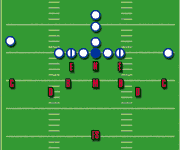 In
the 3-5 defense the alignment places our Defensive Ends head up
over the offensive tackles and our Nose Guard aligned over the center.
The linemen are taught to attack the backfield and get flat to the
ball. The defensive lines play allows linebacker to run and make
plays. The linebackers are stacked behind defensive linemen. Our
outside backers, dog safeties, are aligned off the end man on the
line of scrimmage. The dogs usually are given the freedom to move
between an area of 3-5 yards outside the end man on line of scrimmage
and 3-8 yards away from the line of scrimmage. They must be in the
correct position when the play starts. The Free Safety is behind
the Mike linebacker at 10-12 yards deep. The corners are aligned
7 yards off the ball over the widest man to their man to their side
of the field. The following is the basic alignment for our defense
(Diagram 1). In
the 3-5 defense the alignment places our Defensive Ends head up
over the offensive tackles and our Nose Guard aligned over the center.
The linemen are taught to attack the backfield and get flat to the
ball. The defensive lines play allows linebacker to run and make
plays. The linebackers are stacked behind defensive linemen. Our
outside backers, dog safeties, are aligned off the end man on the
line of scrimmage. The dogs usually are given the freedom to move
between an area of 3-5 yards outside the end man on line of scrimmage
and 3-8 yards away from the line of scrimmage. They must be in the
correct position when the play starts. The Free Safety is behind
the Mike linebacker at 10-12 yards deep. The corners are aligned
7 yards off the ball over the widest man to their man to their side
of the field. The following is the basic alignment for our defense
(Diagram 1).
Keys to Execution
The key to success for the 3-5 defense is the ability to stunt and
blitz from all areas of the defense. Based on the alignment in figure
1, we were able to move the linemen in a direction determined by
formations, down and distance, and the offense’s favorite plays.
The defensive line responsibilities are made simple, based on our
philosophy that we must control the line of scrimmage. We make playing
defense line simple so that they can be aggressive in their attack.
Our defensive ends and nose guards are very quick and are seldom
asked to take on a base block. The movement of the defensive linemen
requires offenses to account for them. Based on this thought, an
attempt to block our defensive linemen must be made by two or more
offensive linemen. The defensive linemen move in the same direction
accordingly with the stunt and blitz called to allow linebackers
to hit the correct gaps.
We drill and constantly stress the option responsibilities in every
blitz and stunt we do. We work on pad level in blitzing, because
a high pad level allows offenses to disrupt the blitz. The linebackers
must be able to attack the line of scrimmage with low pad level
and be ready to redirect to the recognized play. To recognize the
play we run a Key Drill. This is an important part of our practice
where the linebackers learn to recognize formations, sets and plays
the opponents run. The important coaching point is for the linebacker
to understand where the defensive line is stunting and where they
will fit on each play. The linebacker’s ability to read the
play fast and then attack helps us to make plays in the backfield.
The following is a key drill we use to help linebackers with play
recognition. (Diagrams 2,3,4)
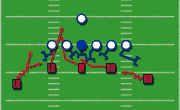 |
Diagram 2. - VS. ISO
Mike - fit inside/out to the football
Left Bat - attack, keep outside arm free
Right Bat - slow read for cut back, fit with the noseguard
Left Dog - buzz feet and be ready to fit inside or outside
as determined by the ball location
Right Dog - slow read for cut back |
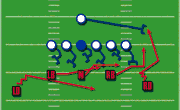 |
Diagram 3. VS. SWEEP
Mike - fast flow - go now and stay inside/out on the
football
Left Bat - slow read away fit with the noseguard for
cut back
Right Bat - fit off the end man on the line of scrimmage
Left Dog - slow read for cut back
Right Dog - attack ball and turn everything back inside |
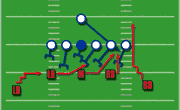 |
Diagram 4. VS. OPTION
The noseguard, Mike, Right Bat and Right End must handle dive
and QB
Mike - read inside out, dive, QB, pitch
Left Bat - slow read fit with the nose for cutback
Right Bat - attack line of scrimmage QB (Mike, Nose,
End have Dive)
Left Dog - slow read for cut back
Right Dog - buzz feet on line of scrimmage until football
location is determined, then to pitch
Free Safety - has dive, QB to pitch |
The Dog safeties are aligned where the Key Drill is vital for them
to be active in the running game and pass coverage. These players
are the most versatile on the field because they are asked to cover
man-to-man, support the run, blitz and zone drop into coverage.
The most important element to executing the defense is not asking
your players to do something they are not used to doing. Often times,
we try to outsmart an offense and ask players to do many different
things. We stayed simple with our approach to this defense by letting
defensive linemen attack, linebackers and Dog safeties blitz, and
the corners along with the free safeties cover. The attacking style
makes the defense a challenge for offenses and fun for our players.
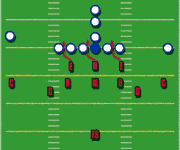
Diagram 5. Slant Left
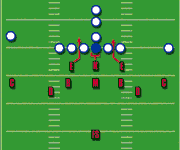
Diagram 6. Pinch
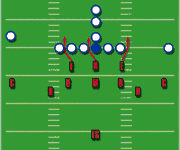
Diagram 7. Up |
|
Constant Movement and Pressure
One of the elements that the 3-5 scheme can offer is mixing up the
depth of who is and who is not going on a stunt, and another element
is in slanting the defensive line. The Dog safeties, Free safety,
Bats and Mike can also prowl back and forth between different areas
with the appearance of a stunt.
The different depths that we can pressure are from 1. Base Alignment,
2. Cheat, 3. Show It and 4. Walk It Up. In Base Alignment we are
keying the ball ready to go on a predetermined path from normal
depths associated with that position. With Cheat, the people on
the stunt will simply move their alignment up to half to distance
that would be normal in Base. Show It means for the people involved
in the stunt to line up in the stunt before the quarterback is fully
under center. Finally, Walk It Up means for everyone involved in
that particular stunt to start off in normal alignment and ease
toward their stunt during the offensive cadence.
What these depths offer us are different speeds of attack and game
plans. In the first game we might Show It, with all stunts knowing
that will be on the film for the next opponent. For the second game
we might Walk It Up, and then the third game Cheat with all stunts.
Another way we stress the offense with our stunt packages is by
Prowling. Our players love to do this and take a lot of pride in
disguising. Prowling is simply the Dog safeties, Free safety, Bats
and Mike moving back and forth, side to side and from gap to gap
at different depths. When we are doing this correctly, it looks
like organized chaos during the snap count. We constantly remind
those Prowling to not take themselves out of responsibility.
Our slants are very basic and correspond with our stunts. We will
slant our Ends and Nose right or left (Diagram 5), pinch (Diagram
6) and up (Diagram 7).
The biggest coaching point that we have picked up with this defense
is to not just teach where to stunt but rather teach how to stunt.
How to fight through, seeing the ball, and how to redirect are all
elements of how to stunt. Where to go is only part of it, but how
to take on the different levels during a play is even more important.
The second coaching point is to make sure each player knows their
responsibility for option in all of the stunts.
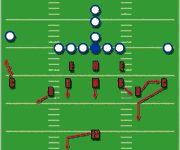
Diagram 8. Cover 2
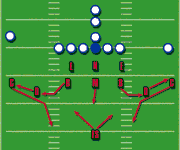
Diagram 9. Cover Two Robber
|
|
Coverage Combinations
The cornerbacks are asked to do one thing and do it very well.
They must be able to cover the side receivers. Whether we are in
zone or man to man the corners cover and support late on the run.
As with most defenses, the Free Safety must run with the defense.
He must know who is blitzing, where the slant is going, and where
he fits with the call. The Free Safety allows us to get the ninth
man in on the run game and allows us to pressure with eight players.
In the 3-5 we have found an unlimited amount of what you can do
coverage-wise. If your team is a Cover 2 program, then a Rotating
Cover 2 can be used (Diagram 8) or an invested Cover 2 with a Robber
(Diagram 9). We have experimented some with 1/4 1/4 1/2’s (Diagram
10). The coverages that we use the most are variations of Man and
Cover Three.
When we are stunting the Dog and Bat on the same side we use One
Roll. In One Roll the Covers have #1, the free safety will roll
down and cover #2 on the side that the Dog and Bat are stunting.
The Bat not going on a stunt and the Mike will take #3. On the opposite
side of the stunt, the Dog will have #2 man (Diagram 11). In this
stunt it is crucial that the Dog on the blitz attack at the second
level for containment and pitch. The Bat is attacking at the first
level and has quarterback on option.
If we are stunting our Bats and Mike, then we will run Cover Zero.
Cover Zero simply says that the offense has five eligible receivers
and we have five defensive backs. The Corners have #1, the Dogs
have #2 and the Free Safety has #3 (Diagram 12).
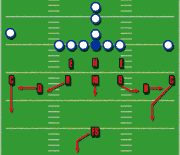
Diagram 10. Cover 1/4 1/4 1/2's |
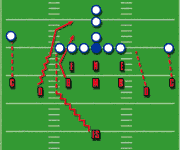 Diagram 11. One Roll
Diagram 11. One Roll |
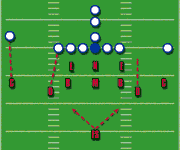 Diagram 12. Cover Zero
Diagram 12. Cover Zero |
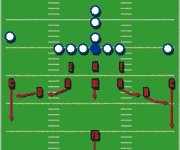 Diagram 13. Cover Three
Diagram 13. Cover Three |
The zone package we run comes out of a three deep principle in
Cover Three. The basic rules are the Corners and Free Safety have
deep 1/3’s, the Dogs have curl/flat, the Bats have hook/curl
and the Mike has the middle hole (Diagram 13). We will also roll
our Cover three responsibilities so that we can add zone pressure
packages.
Raising The Bar
With the 2001 team winning a National Championship and setting a
national record, we know that the 2002 team will have to answer
with success. One of the ways we are challenging the defensive unit
is by using The Three Levels. Level 1 consists of alignment, assignment,
stance and first step. This is the defensive player’s job and
he must be great at this level to be on the field. In our film studies
over the years we have seen that a whopping percentage of the mistakes
by a player could all be traced to poor first step and poor stance.
Level II consists of taking on a guard pull, breaking on the ball,
taking on the second blocker, anything that happens after Level
I. This is the level that we are putting an exclamation point in
Spring Training and Summer Camp. The body position that the player
is in during Level II will determine how they play the guard pull,
break on the ball or take on the second blocker. In taking on the
guard pull, is the defensive player too high? Are we taking on the
guard late, allowing the running back to run inside or early, placing
the running back bouncing outside? If we know where we are during
Level II and how to set it up, then we will earn a lot of Level
III. This is done at every position on defense.
Level III is the big hit or as Ronnie Lott says, “The Woo Lick”,
the interception, the caused fumble, picking up the fumble or a
perfect fundamental solo tackle. These are the rewards of that play,
and we want each player to increase their chances of making the
reward happen. The only way a player can make Level III is by being
great at Level II. The only way a player can be great at Level II
is by being great at Level I. Using this philosophy has really challenged
us as coaches to make our drills meet the demands of The Three Levels.
Our players are challenged in their drill work to get better at
Level II and are ready to take that to team periods and thus to
the game field.
|
Bert Williams
& Taylor Burks
Bert Williams began
his coaching career as a graduate assistant under Ray
Goff at the University of Georgia. Williams also coached
at Union College in Kentucky where he served as the
Assistant Head Coach and Offensive Coordinator. Williams
held these same positions at GMC prior to his promotion
to Athletic Director and Head Coach. His overall record
as a head coach is 18-3. He was also named NJCAA 2001
Head Coach of the year. Williams was a three-year starter
at offensive tackle at Davidson College where he earned
his Bachelor of Arts degree.
Taylor Burks was GMC’s linebackers and strength
and conditioning coach in 2001 and will take over as
Defensive Coordinator in 2002. Burks, a graduate of
Mississippi State University, got his master’s
degree from Georgia College and State University while
serving as a graduate assistant at GMC.
|
|
|
GEORGIA MILITARY COLLEGE
DEFENSE
Inside the Numbers:
(Regular season)
82:
Net Rushing Yards Allowed
758: Net
Passing Yards Allowed
676: Net
Total Off. Yards Allowed
5: TDs
Allowed
55: Sacks:
55
97: Tackles
for a Loss
21: Interceptions
9: Defensive
Touchdowns
40: Pass
Break Ups
Since 1991:
• 2001 NJCAA National Champions
• Finished in the top 15 six times
• Finished in the top 10 four times
• Finished in the top 5 three times
|
|
|
 In
the 3-5 defense the alignment places our Defensive Ends head up
over the offensive tackles and our Nose Guard aligned over the center.
The linemen are taught to attack the backfield and get flat to the
ball. The defensive lines play allows linebacker to run and make
plays. The linebackers are stacked behind defensive linemen. Our
outside backers, dog safeties, are aligned off the end man on the
line of scrimmage. The dogs usually are given the freedom to move
between an area of 3-5 yards outside the end man on line of scrimmage
and 3-8 yards away from the line of scrimmage. They must be in the
correct position when the play starts. The Free Safety is behind
the Mike linebacker at 10-12 yards deep. The corners are aligned
7 yards off the ball over the widest man to their man to their side
of the field. The following is the basic alignment for our defense
(Diagram 1).
In
the 3-5 defense the alignment places our Defensive Ends head up
over the offensive tackles and our Nose Guard aligned over the center.
The linemen are taught to attack the backfield and get flat to the
ball. The defensive lines play allows linebacker to run and make
plays. The linebackers are stacked behind defensive linemen. Our
outside backers, dog safeties, are aligned off the end man on the
line of scrimmage. The dogs usually are given the freedom to move
between an area of 3-5 yards outside the end man on line of scrimmage
and 3-8 yards away from the line of scrimmage. They must be in the
correct position when the play starts. The Free Safety is behind
the Mike linebacker at 10-12 yards deep. The corners are aligned
7 yards off the ball over the widest man to their man to their side
of the field. The following is the basic alignment for our defense
(Diagram 1).










